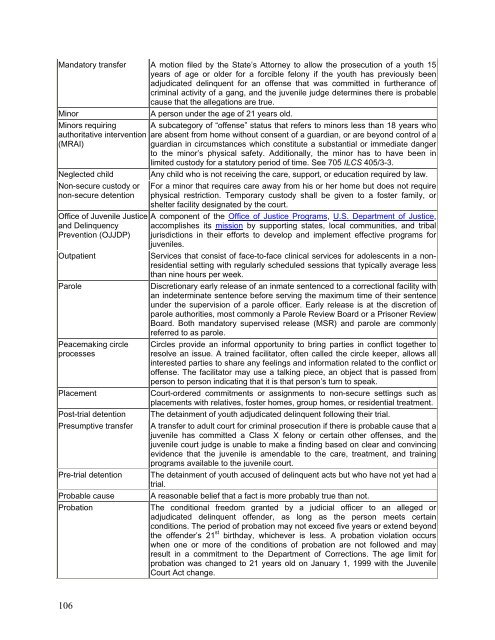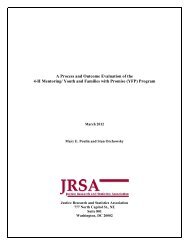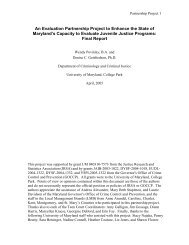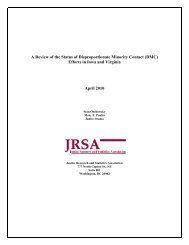Juvenile Justice System and Risk Factor Data - Illinois Criminal ...
Juvenile Justice System and Risk Factor Data - Illinois Criminal ...
Juvenile Justice System and Risk Factor Data - Illinois Criminal ...
You also want an ePaper? Increase the reach of your titles
YUMPU automatically turns print PDFs into web optimized ePapers that Google loves.
M<strong>and</strong>atory transfer A motion filed by the State’s Attorney to allow the prosecution of a youth 15<br />
years of age or older for a forcible felony if the youth has previously been<br />
adjudicated delinquent for an offense that was committed in furtherance of<br />
criminal activity of a gang, <strong>and</strong> the juvenile judge determines there is probable<br />
cause that the allegations are true.<br />
Minor<br />
A person under the age of 21 years old.<br />
Minors requiring<br />
authoritative intervention<br />
(MRAI)<br />
Neglected child<br />
Non-secure custody or<br />
non-secure detention<br />
Office of <strong>Juvenile</strong> <strong>Justice</strong><br />
<strong>and</strong> Delinquency<br />
Prevention (OJJDP)<br />
Outpatient<br />
Parole<br />
Peacemaking circle<br />
processes<br />
Placement<br />
Post-trial detention<br />
Presumptive transfer<br />
Pre-trial detention<br />
Probable cause<br />
Probation<br />
A subcategory of “offense” status that refers to minors less than 18 years who<br />
are absent from home without consent of a guardian, or are beyond control of a<br />
guardian in circumstances which constitute a substantial or immediate danger<br />
to the minor’s physical safety. Additionally, the minor has to have been in<br />
limited custody for a statutory period of time. See 705 ILCS 405/3-3.<br />
Any child who is not receiving the care, support, or education required by law.<br />
For a minor that requires care away from his or her home but does not require<br />
physical restriction. Temporary custody shall be given to a foster family, or<br />
shelter facility designated by the court.<br />
A component of the Office of <strong>Justice</strong> Programs, U.S. Department of <strong>Justice</strong>,<br />
accomplishes its mission by supporting states, local communities, <strong>and</strong> tribal<br />
jurisdictions in their efforts to develop <strong>and</strong> implement effective programs for<br />
juveniles.<br />
Services that consist of face-to-face clinical services for adolescents in a nonresidential<br />
setting with regularly scheduled sessions that typically average less<br />
than nine hours per week.<br />
Discretionary early release of an inmate sentenced to a correctional facility with<br />
an indeterminate sentence before serving the maximum time of their sentence<br />
under the supervision of a parole officer. Early release is at the discretion of<br />
parole authorities, most commonly a Parole Review Board or a Prisoner Review<br />
Board. Both m<strong>and</strong>atory supervised release (MSR) <strong>and</strong> parole are commonly<br />
referred to as parole.<br />
Circles provide an informal opportunity to bring parties in conflict together to<br />
resolve an issue. A trained facilitator, often called the circle keeper, allows all<br />
interested parties to share any feelings <strong>and</strong> information related to the conflict or<br />
offense. The facilitator may use a talking piece, an object that is passed from<br />
person to person indicating that it is that person’s turn to speak.<br />
Court-ordered commitments or assignments to non-secure settings such as<br />
placements with relatives, foster homes, group homes, or residential treatment.<br />
The detainment of youth adjudicated delinquent following their trial.<br />
A transfer to adult court for criminal prosecution if there is probable cause that a<br />
juvenile has committed a Class X felony or certain other offenses, <strong>and</strong> the<br />
juvenile court judge is unable to make a finding based on clear <strong>and</strong> convincing<br />
evidence that the juvenile is amendable to the care, treatment, <strong>and</strong> training<br />
programs available to the juvenile court.<br />
The detainment of youth accused of delinquent acts but who have not yet had a<br />
trial.<br />
A reasonable belief that a fact is more probably true than not.<br />
The conditional freedom granted by a judicial officer to an alleged or<br />
adjudicated delinquent offender, as long as the person meets certain<br />
conditions. The period of probation may not exceed five years or extend beyond<br />
the offender’s 21 st birthday, whichever is less. A probation violation occurs<br />
when one or more of the conditions of probation are not followed <strong>and</strong> may<br />
result in a commitment to the Department of Corrections. The age limit for<br />
probation was changed to 21 years old on January 1, 1999 with the <strong>Juvenile</strong><br />
Court Act change.<br />
106

















